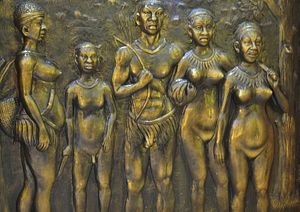Despite the considerable antiquity of Indian civilization, with some sites in what is today northwest India and Pakistan dating from over five thousand years ago, the origins of today’s Indians have long been shrouded by the depths of time, a murky morass for archaeologists and historians. However, 2018 was rightly described as the golden age of Indian population genetics, because DNA evidence, modern and ancient, combined with archaeology and linguistics, has finally unraveled the origins of Indians. We now have a good idea of where Indians come from, after decades of mystery.
What has emerged is a picture of Indian origins that aptly reflects the present diversity of South Asia. Indians — their civilization, language, and religion — are the multilayered, composite product of many different sources, now mixed to produce the modern population.
Origins
Aboriginal Indians. A significant portion of Indian DNA, almost half by some accounts, is derived from the aboriginal inhabitants of India, possibly descendants from the human populations that arrived there in the first waves of migration out of Africa by 50,000 years ago; in present-day India, the tribes of the Andaman islands, with a physiological profile most similar to modern Australian aborigines and New Guineans, are the taken to be the most representative of this ancient population, which has been labeled by geneticists as Ancient Ancestral South Indians (AASI), somewhat of a misnomer since this population is a major component of the DNA of all South Asians. AASI DNA is particularly prominent in mitochondrial DNA (passed through the female line), indicating that there was consistent selective mixing between aboriginal women and high-status males from populations from outside of India, probably buoyed by innovative technologies such as agriculture and metallurgy.
Iranian Farmers. Much of the rest of Indian DNA comes from the Middle East, with some input from the Central Asian steppe. Originally, this genetic population was labeled Ancestral North Indian (ANI), since this genetic component is more prominent in North India. However, it is also a deliberate misnomer, chosen for political reasons so as not to offend Hindu nationalists, that obscures the non-Indian origin of these people. Humanity was much more diverse in terms of languages and physical features before the spread of agriculture and animal husbandry a few thousand years ago. For example, ancient Europeans had dark skin and blue eyes. But as a result of agriculture in the Near East and China, farmers fanned out from these regions, spread their languages, and displaced or assimilated the native populations of Europe, India, and Southeast Asia. Some farmers from western Iran, one of the homelands of agriculture, migrated east to the Indus Valley in modern Pakistan by 9,000-7,000 years ago, where they remained without further expansion for a few thousand of years because, according to geneticist Razib Khan, “the West Asian agricultural toolkit [crops like wheat] was serviceable in northwestern South Asia for reasons of climate and ecology, but could not expand further east and south.”
Southeast Asian Rice Farmers. It was in India that the two waves of agriculture and population movements, fanning out from the Middle East and China respectively, met. While wheat was introduced from the west, rice was brought by Austro-Asiatic groups, today represented by the Mundas in eastern India, part of a language family that includes Vietnamese and Khmer. While Austro-Asiatic farmers seem to have originated from southern China, and displaced the original AASI-like inhabitants of Southeast Asia, by the time these rice farmers reached India around 4,000 years ago, they seemed to have become more dispersed. Most Austro-Asiatic Indian groups are in fact genetically mostly aboriginal, with some male East-Asian ancestry; other than rice and some isolated languages, the Austro-Asiatic groups seem to have made little impact on Indian genetics and culture, though the proportion of East-Asian like ancestry in some eastern Indian ethnic groups like the Bengalis is not minuscule. Due to climate, rice seems to have been adapted by all groups and spread throughout the subcontinent soon after its arrival, so the Munda did not have a particular advantage.
Note: I have endeavored to faithfully distill academic literature without modifying academic terminology too much; nonetheless, I have simplified and edited some ideas for clarity. My primary sources are the geneticists David Reich, Razib Khan, and Vagheesh M. Narasimhan et. al., as well as recent genetic evidence from ancient skeletons at Rakhigarhi, Haryana.

































